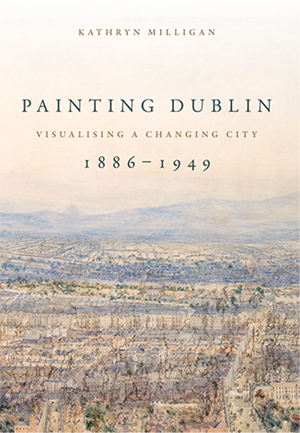PAINTING DUBLIN 1886–1949: VISUALISING A CHANGING CITY
Published in Book Reviews, Book Reviews, Issue 4 (July/August 2021), Reviews, Volume 29 KATHRYN MILLIGAN
KATHRYN MILLIGAN
Manchester University Press
£80
9781526144102
Reviewed by Sylvie Kleinman
Sylvie Kleinman is a Visiting Research Fellow at Trinity College, Dublin, and a former Governor and Guardian of the National Gallery of Ireland.
This lucid book moves beyond conventional Irish art history and representations of Dublin. While visually, landscape and the west somewhat defined the national idyll, writers became emblematic of Dublin, and Joyce the quintessential Irish flâneur. The creative agency of this detached yet observant stroller, ubiquitous in literary representations of modernism, is evidently referenced by Kathryn Milligan who convincingly argues that artists too were urban observers. Her timespan covers the crucial years when Dublin was transformed from a capital of empire to the capital of the Irish republic, 1886 to 1949. She naturally invokes gender when considering the flâneur in the influential new genre of Impressionism. Women were initially mostly the observed, but as their lives were fundamentally changing during these pivotal decades, female artists enjoyed new freedoms. In urban settings like the area around Patrick Street, to Dickens the most wretched part of Dublin, they could now legitimately pause and sketch. Not so however under the Defence of the Realm Act (1914), when one needed a Dublin Metropolitan Police permit; Milligan duly researched this when discussing Estella Solomons, confined to parks after infringing the DORA by sketching without one on Wellington Quay.
More or less chronologically, the book discusses how six artists visualised themes ranging from dockers, dancers and drinkers to poverty and parks, and evidently so-called old and vanishing Dublin. Not limited to painting, it discusses the varied perceptions of Walter Osborne, Rose Barton, Jack B. Yeats, Harry Kernoff, Solomons and Flora Mitchell, locating their approaches to the picturesque within international traditions and evolving genres. Displays of art specifically representing Dublin are infrequent, Milligan writes, though one notable exception was ‘Drawing Dublin’ at the National Gallery of Ireland (2018), which she herself curated. Might one suggest that this lack of an identifiable artistic heritage could be solved within a museum dedicated to the capital, the absence of which is certainly unique in Europe?
Dublin, as Ireland’s art capital, provided institutional supports such as education, studio life and societies, and opportunities for viewing, exhibiting and selling. Its Metropolitan School of Art attracted students from all over the island, and the Royal Hibernian Academy had been promoting the fine arts and holding exhibitions since 1826, as did other venues. The original Academy House on Abbey Street was destroyed by fire in 1916, and with it the annual show, but revolution does not overwhelm this narrative. The new realism and naturalism emerging during Osborne’s career resulted in a shift towards non-moralising quotidian scenes, observing the humble and commonplace. He and others represented Dublin’s very visible impoverished children or ‘town sparrows’ (p. 34), reflecting the public’s appetite for such views. Osborne’s and Barton’s scenes of the bustling Patrick Street area also documented its infamous dilapidation (outdoors), erased by the 1899 Dublin Improvement Act. While their hushed tones and a cathedral steeple in the backdrop may have rendered the squalor impressionistic and marketable, by then concerns were mounting about urban poverty, indoors. Yeats’s modernism and bold outlines captured Dublin in a new characterisation of the city as a place of alienation and despair, while innovative styles emphasised difference and fragmentation. Urban lightness and darkness, the creative exploitation of a shadow highlighting archways as electricity was replacing gaslight, permeate the book’s abundant, high-quality illustrations.
Milligan’s engaging prose is not weighed down by jargon. Her study of Kernoff is an insightful counterpoint to the other privileged, middle-class native artists. His unique iteration of Dublin’s jazz age and the theatre scene characterised a hybrid form of modernism, blending Cubism, Futurism and Expressionism. Kernoff, politically radical, moved on to social realism and depicted both the worker and the unemployed, ably capturing industrial but equally picturesque cityscapes and emblematic monuments. These are the instant identifiers of any locality, but there are people, mostly humble, in virtually every illustration. We look again and see how a shawled woman against an urban backdrop could appear as romanticised as in windswept Connacht. We learn how some artists aestheticized the documented hardships of tenement-dwellers, often somehow evoking the past. Milligan concludes that the marginal place of the city within the wider conversation around Irishness had, until recently, contributed to a lack of engagement with urban life. Her book is therefore timely, as we now better perceive Dublin as a centre of political motion and associational life on the eve of revolution. The book also references the early historicisation of a (select) Dublin, its former medieval core and the Georgian city between the canals, and how this was projected as emblematic of a past worth remembering. This is counterbalanced by Dublin Corporation’s little-known Book of Dublin (1929), which rebranded the city as the vibrant capital of the Free State: in it Kernoff creatively foregrounded telephone wires and electricity posts, the signifiers of progress. Beyond its own discipline, Painting Dublin challenges us to reflect on a more open, interpretative and alternative understanding of how Irish visual identity was shaped.
















